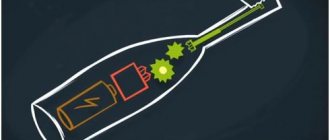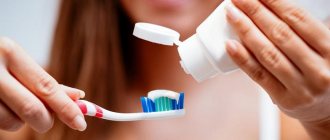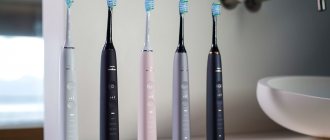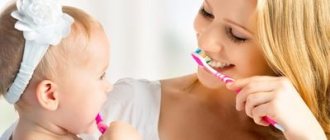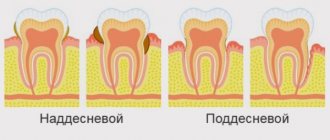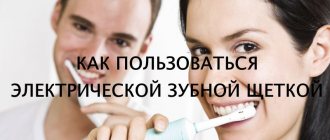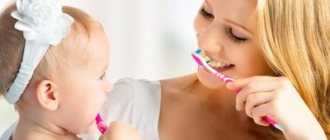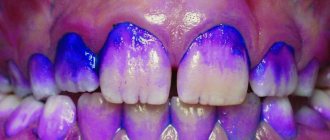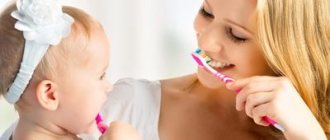To maintain dental health at any age, daily oral hygiene is extremely important. It would seem a simple procedure that does not take much time and does not require any extraordinary skills and efforts. But sometimes even adults are too lazy to do it regularly. What then can we say about kids? They don't even suspect such a need. How to teach a child to brush their teeth every day - morning and evening? What parenting tricks can you use to achieve the best results?
Baby 1 year old
At 1-2 years old, a child cannot yet brush his teeth on his own. But in order to develop a stable habit, this procedure can be carried out by parents until the baby grows up a little.
According to dentists, a child should start brushing his teeth when the very first ones have just erupted. For some it happens earlier, for others later.
But when the baby turns 1 year old, he definitely already has a couple of teeth in his mouth. And they require proper care. While the child does not know how to brush his teeth on his own, one of the parents does it for him using a special silicone brush.
Carry out this procedure regularly after your baby wakes up in the morning and before bed. This will be the initial stage of teaching a child to mandatory and regular brushing of teeth. And when your baby gets a little older, you can safely start teaching him to brush his teeth on his own.
Cleaning technology with installed braces
Restoring correct occlusion with braces is an important stage of dental treatment.
But this may cause a side effect in the form of hard deposits or caries. This is due to the fact that it is quite difficult to reach the surface located behind the braces.
To avoid this, it is necessary to approach the cleaning procedure with special care, which is carried out in several steps:
- Place any type of brush at an acute angle (45°) relative to the front surface of the tooth.
- Using gentle pressure, begin to clean the crown, alternating back and forth. This action removes plaque from both the internal and external surfaces.
- After this, start cleaning the bracket. To do this, brush the brush several times, first from the gum line to the cutting part, then vice versa. When doing this, avoid pressing too hard to avoid damaging the structure.
- Then, carry out the procedure for cleaning the crown of the chewing part, placing the brush perpendicularly. The movements should be circular, with slight pressure. But do not overdo it, as you can injure your gums.
- Repeat a similar process on each tooth. The time for one section is 10 seconds.
To care for teeth with installed braces, it is recommended to use a special brush and additional devices (brush, floss, irrigator).
A brush for such purposes should have a structured shape, where the bristles are shortened towards the middle along the entire length of the head. Ideally, this shape should resemble the letter “V”.
Next is a training video on how to care for braces:
Child 4-5 years old
By the age of 4-5, many toddlers have already developed a stable habit of brushing their teeth. And parents can begin to draw their attention to the quality of the procedure.
Be patient. You are unlikely to be able to immediately teach your child to take care of his teeth. And that's okay. Moreover, for several more years (approximately until the toddler reaches school age) you will have to control the process itself. Since the baby still cannot properly brush his teeth on his own.
Technology using thread (floss)
Dental floss is used to remove food debris and plaque in places where it is difficult for a standard brush to penetrate. Usually this is the interdental space, the distance between the orthodontic system, and the cervical area.
Before using this thread, you should correctly decide on its choice. Two types of floss are used for teeth:
- Nylon . Suitable for crowns with standard or wide interdental spaces. Removes plaque well.
- Teflon . Thinner than the first option, therefore it is recommended for people with a small gap between the crowns.
Floss will have a good effect only if used correctly:
- For cleaning you will need about 35 cm of thread. Measure it from the main coil and tear it off;
- wrap the ends of the thread around your index fingers;
- adjusting the tension of the floss with your thumbs, carefully pass it between the crowns;
- moving the thread up and down, clean the adjacent surfaces;
- after this, floss in the cervical area, covering the area under the gum;
- remove the floss by alternately pulling back and forth, while lifting;
- In the same way, carry out the procedure to remove deposits on the remaining teeth, using an untouched section of the floss. During this process, avoid sudden movements and excessive force to avoid cutting the gum tissue.
Below is a video with dentist tips on using floss:
Recommendations for parents
- Brushing your teeth should not be a routine task for your child. Let it be in a playful way. So that the baby wants to repeat the procedure again and again.
- At the initial stage of your child’s education, your priority is to develop a habit, and not to teach the correct manual skills (how to hold a brush and how to move it, how long to brush your teeth, etc.). First, the baby must understand the importance of what he is doing, become interested, be inspired, and only then begin to follow the process itself.
- Therefore, after your little one brushes her teeth, be sure to check the result and clean them. Explain that not all evil caries were driven away by the child. Next time, let him try to reach with a brush all the nooks and crannies where they might be hiding.
Your child’s healthy, white-toothed smile in the future depends entirely on your patience, your perseverance and responsibility in the present.
Forming your child’s skills and established habit of brushing their teeth depends entirely on you. Be patient and moderately persistent. Your reward will be your child’s beautiful and happy smile for many, many years. And the knowledge that it was you who helped preserve this white-toothed smile.
Technology using different types of brushes
Improper cleansing is one of the main causes of diseases of dental and periodontal tissue. Even though most people know the general rules for cleaning their mouth, it is not always effective.
First of all, it depends on the type of brush used, since each device requires its own technology.
Regular
This process, using a standard brush, should last at least three minutes . The number of procedures cannot be less than twice a day. The best option is to use the brush after eating.
The process itself consists of several steps:
- wet the brush with water and apply the required amount of paste;
- start the procedure from the upper jaw, visually dividing it into two segments;
- the process should begin with the front incisors, gradually moving towards the molars;
- position the brush in relation to the front surface at an angle of 45°, at the base of the crown;
- Using a sweeping motion, from the gum pocket to the cutting part, we clean the front sides of the tooth;
- when working on the inside, the brush must be directed at a slight angle vertically;
- The cutting surface is cleaned using circular movements. In this case, the brush is positioned perpendicular to the chewing side;
- We process the bottom row in the same way.
- Finally, clean your tongue and rinse your mouth with water or mouthwash.
Next is a training video with visual examples of using a regular toothbrush:
Electrical
An electric brush is an effective means of removing deposits from enamel. It allows cleaning without any effort, since when turned on it makes circular movements at maximum speed.
But when using it, you must remember that such a device can cause harm in case of periodontal diseases, leading to high tooth mobility. Use after surgery in the oral cavity is also contraindicated.
Step-by-step description of the procedure for cleansing the oral cavity with an electric brush:
- moisten the brush under running water and apply the required amount of paste. Do not squeeze out a large amount of paste, as the high speed of the device may cause the formation of excessive foam. This will complicate the cleaning procedure and increase its time;
- Place the device horizontally so that the bristles of the head cover the chewing surface of the crown and turn on the device. Start the procedure from the front incisors, gradually moving towards the back teeth;
- hold the brush in this position for 3 or 4 seconds. Light reciprocating movements of the device along the crown are allowed;
- move the device to a vertical position and process the inside and outside;
- After completely cleaning one tooth, move the brush to another with a smooth movement.
The following video will teach you how to use an electric toothbrush correctly:
Ultrasonic
An ultrasonic brush is a tool that cleans crowns using high-frequency waves. This device allows you to remove pathogenic particles not only on the visible part, but also in the gum pockets at a depth of up to 4 mm .
Detailed usage description:
- Before use, set the required mode. As a rule, brushes of this type have several modes: standard, with or without vibration, and enhanced.
- A small amount of paste is applied to moistened bristles. Typically no larger than the size of a pea is recommended;
- start the process from the farthest molar;
- position the head of the device at an acute angle to the inside of the crown;
- turn on the device and, using circular movements, first clean the gum pocket, and then the entire surface of the crown, gradually moving towards the chewing part;
- The same method is used to remove plaque from the outer part;
- The chewing side is treated with a brush located horizontally. In this case, it is necessary to make movements back and forth on the surface;
- Excessive physical effort should be avoided during the cleansing process. It should take at least 1.5 minutes to treat the dentition of one jaw.
The following video contains recommendations for the correct use of a sonic toothbrush (watch from the 4th minute):
Monobeam
The monobeam brush appeared not so long ago, but has already gained great popularity. With it you can easily clean all hard-to-reach places, including interdental spaces and gum pockets . This made the brush popular among people with orthodontic structures.
The device is very convenient to use, as it is small in size. It can also be used without toothpaste.
To get the proper result, you must carry out the cleansing procedure correctly:
- visually determine the segments of the dentition and the order of cleaning. We start work from any segment convenient for you;
- One of the important nuances when using a mono-beam brush is the correct grip of the handle. Fingers must be placed on power ledges to prevent slipping;
- place the device at an angle (approximately 45°) to the tooth line bordering the gum;
- moving in a semicircle, as if sweeping out a gum pocket;
- after which we clean the internal, external and cutting surfaces in a circular motion;
- During the process, you should not make special efforts so as not to injure the mucous tissue. The procedure for cleaning one tooth lasts about 10 seconds.
Using this device is very simple - watch the video:
We have prepared instructions for Crest Whitestrips teeth whitening strips in a special publication.
We invite you to look at the photo and find out what periodontitis looks like.
Here: https://zubovv.ru/ortodontiya/breketyi/skolko-stoyat-na-zubyi-dlya-korrektsii-prikusa.html - we’ll tell you how much sapphire braces cost.
Video “When should you start teaching your baby to brush his teeth?” Komarovsky
- Author: Polina
Hello. My name is Polina. Having once heard the truth that a pediatrician is the main doctor for any family with small children, I realized that I had something to strive for. Rate this article:
- 5
- 4
- 3
- 2
- 1
(1 vote, average: 3 out of 5)
Share with your friends!
Oral hygiene or rules for choosing toothpaste and brushes for a baby.
Where to celebrate New Year with a child (if the baby is only 1-2 years old)
How to choose baby toothpaste?
It is important to focus on the level of its abrasiveness. This indicator tells how much the composition erases tooth enamel when brushing, and is denoted by the abbreviation RDA. For children, a maximum of 20 RDA is acceptable, while for adults a level of 70 to 100 is safe.
In addition, baby toothpaste should not contain calcium carbonate and sodium bicarbonate, as these are harsh abrasives that can damage enamel. Instead, it is better to choose formulations with titanium or silicon dioxide.
Sodium lauryl sulfate, or SLS, is also toxic for children; it can dry out the mucous membranes and cause allergies. However, it is safe for adults. It is added to the paste to give it foaming properties. Accordingly, if the toothpaste produces abundant foam, this component is present in it.
To make it easier for your child to get used to the procedure, brush your teeth with him
The same reactions - dry mucous membranes and allergies - can be caused by parabens, which are used to preserve the composition and give it antiseptic properties.
Regarding fluoride content, the European Academy of Pediatric Dentistry (EAPD) recommends toothpastes with this component for everyone, including children after the eruption of their first tooth. Fluoride is necessary for the prevention of caries. In paste for children under four years old it should contain 200 ppm, children from four to eight years old need 500 ppm, and after eight years old - 1450 ppm.
In addition, fluoride has an alternative - synthetic hydroxyapatite, which is identical to natural hydroxyapatite, which makes up tooth enamel. This substance is easily integrated into the crystal lattice and strengthens it, sealing all microcracks, reduces sensitivity and prevents the development of caries. The only disadvantage of pastes with hydroxyapatite is that they are more expensive than fluoride ones.
The sooner you start paying attention to your child’s oral cavity, the faster and easier he will learn to take care of his teeth. If the baby was not taught to brush his teeth while he was very young, everything can be corrected. The main thing is to be patient and act consistently, then over time the procedure will become a familiar ritual for him
Technology using an irrigator
Not long ago, an irrigator was introduced into use. This device is capable of cleaning all hard-to-reach areas using pressurized water without causing harm to dental and periodontal tissue .
In addition, this design involves the use of not only water, but also medicinal products.
The irrigator, like other devices, requires proper use:
- lean over the sink, set the required liquid flow rate and turn on the device;
- start with the furthest molars. Point the irrigator head at the space between them at a right angle and apply liquid;
- after this, transfer the stream to the gum pocket, washing away plaque from there and performing an additional massage;
- Finally, treat the rest of the tooth;
- walk in the same way along the entire row of teeth in both jaws. The entire procedure should take at least 5 minutes, but no more than 15.
Below is a short video on the correct use of the irrigator:
Find out how long an adult should wear braces to correct their bite.
This article names only the best medications for toothache.
Here: https://zubovv.ru/krasota-i-uxod/zubnyie-shhetki/elektricheskie-oral-b-professionalnaya-zabota-v-domashnih-usloviyah.html - the Oral Bee Triumph 5000 electric toothbrush is described.
